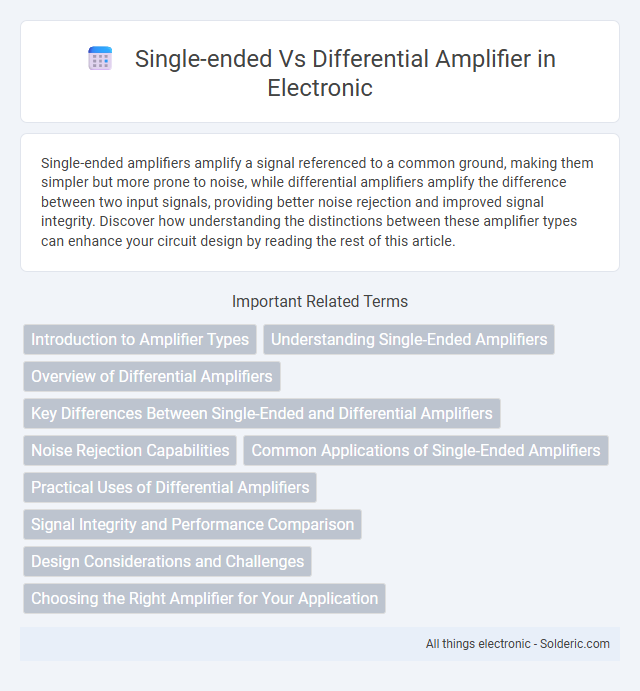Single-ended amplifiers amplify a signal referenced to a common ground, making them simpler but more prone to noise, while differential amplifiers amplify the difference between two input signals, providing better noise rejection and improved signal integrity. Discover how understanding the distinctions between these amplifier types can enhance your circuit design by reading the rest of this article.
Comparison Table
| Feature | Single-Ended Amplifier | Differential Amplifier |
|---|---|---|
| Input | One signal input referenced to ground | Two signal inputs, amplifies difference |
| Output | Amplifies signal vs ground | Amplifies voltage difference between inputs |
| Noise Rejection | Low noise rejection | High common-mode noise rejection |
| Complexity | Simple design | More complex circuitry |
| Applications | Audio, sensors with single output | Instrumentation, balanced signal lines |
| Common-Mode Rejection Ratio (CMRR) | Low CMRR | High CMRR |
| Output Signal | Single polarity | Positive and negative polarity |
Introduction to Amplifier Types
Single-ended amplifiers utilize a single input signal referenced to ground, producing an output that mirrors the input voltage, commonly used in simple audio and RF applications. Differential amplifiers amplify the voltage difference between two input signals, offering superior noise rejection and increased signal integrity in environments prone to interference. Key parameters distinguishing these amplifier types include input impedance, common-mode rejection ratio (CMRR), and signal-to-noise ratio (SNR), influencing their suitability for various electronic circuits.
Understanding Single-Ended Amplifiers
Single-ended amplifiers amplify input signals referenced to a common ground, making them simpler but more prone to noise and distortion. Their design typically uses one active device, such as a transistor or operational amplifier, to drive the output voltage relative to ground. Your choice of a single-ended amplifier suits applications requiring straightforward circuitry and lower cost but may compromise on noise immunity compared to differential amplifiers.
Overview of Differential Amplifiers
Differential amplifiers amplify the voltage difference between two input signals while rejecting any voltage common to both, enhancing noise immunity and signal integrity. Unlike single-ended amplifiers that amplify a single input relative to ground, differential amplifiers use two active inputs, making them ideal for applications requiring high precision and low distortion, such as sensor signal conditioning and audio equipment. Your choice of a differential amplifier improves common-mode noise rejection, essential for reliable performance in electrically noisy environments.
Key Differences Between Single-Ended and Differential Amplifiers
Single-ended amplifiers amplify a single input signal relative to ground, making them simpler but more susceptible to noise and interference. Differential amplifiers process two input signals simultaneously, amplifying the voltage difference between them, which enhances noise rejection and improves signal integrity. This fundamental difference results in differential amplifiers being preferred in applications requiring high common-mode noise rejection and precise signal amplification.
Noise Rejection Capabilities
Differential amplifiers excel in noise rejection by amplifying the voltage difference between two inputs while effectively canceling out common-mode noise signals. Single-ended amplifiers, in contrast, amplify a single input signal relative to ground, making them more susceptible to power supply noise and electromagnetic interference. Your choice of amplifier can significantly impact signal integrity, especially in environments with high noise levels.
Common Applications of Single-Ended Amplifiers
Single-ended amplifiers are commonly used in audio equipment, such as guitar amplifiers and hi-fi stereo systems, where simple design and cost-effectiveness are crucial. They are also prevalent in low-frequency signal amplification, including radio receivers and sensor signal conditioning, due to their straightforward implementation and minimal component count. Your choice of a single-ended amplifier suits applications requiring moderate gain with a focus on linearity and low distortion in low-noise environments.
Practical Uses of Differential Amplifiers
Differential amplifiers are widely used in applications requiring high noise immunity and accurate signal extraction, such as audio equipment, sensor signal conditioning, and communication systems. Unlike single-ended amplifiers, differential amplifiers amplify the difference between two input signals, effectively rejecting common-mode noise and interference, which enhances signal integrity in your circuits. Practical uses include instrumentation amplifiers for precision measurements, balanced audio input stages, and data acquisition systems where minimizing noise and distortion is critical.
Signal Integrity and Performance Comparison
Single-ended amplifiers process signals referenced to a common ground, often resulting in higher susceptibility to noise and interference, which can degrade signal integrity in electrically noisy environments. Differential amplifiers amplify the voltage difference between two inputs, effectively canceling common-mode noise and providing superior performance in terms of signal-to-noise ratio and distortion reduction. Your choice between these amplifiers should consider the application's noise environment and required precision, as differential designs excel in maintaining signal fidelity under challenging conditions.
Design Considerations and Challenges
Single-ended amplifiers require careful management of common-mode noise and limited signal range, often facing challenges with ground reference stability and distortion. Differential amplifiers provide superior noise rejection and improved linearity by processing two opposite-phase inputs, but their design demands precise component matching and balanced impedance to maintain signal integrity. Your choice depends on trade-offs between complexity, noise tolerance, and application-specific requirements.
Choosing the Right Amplifier for Your Application
Selecting the right amplifier depends on signal integrity and noise rejection requirements; differential amplifiers excel in environments with high noise due to their ability to amplify the voltage difference between two inputs while rejecting common-mode signals. Single-ended amplifiers are suitable for simpler circuits with lower noise levels and require only one input reference, making them cost-effective for applications like audio amplification. Key factors influencing the choice include signal source impedance, power consumption, and the need for common-mode noise rejection in the target application.
single-ended vs differential amplifier Infographic

 solderic.com
solderic.com